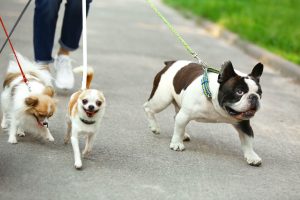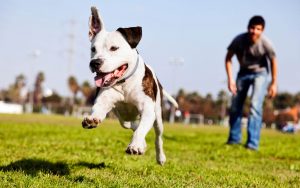The Importance Of Exercising Your Dog and Why Your Dog Needs It

No matter the age, breed, or size, every dog needs regular exercise. Proven over time, a tired dog is better behaved, calm, focused, and understanding. Regular exercise doesn’t just benefit them, it can benefit you too.
Exercising keeps your dog healthy and limber while reducing behavioural problems such as excessive licking, barking, chewing, digging, and other anxiety-related behaviours. It also helps your dog build trust and confidence in you and in their environment.
Why My Dog?
If you don’t know how much exercise your dog needs, we’ve got you covered. Obesity is one of the most common health concerns for dogs. Your first step should be taking your dog to the vet and find an ideal weight goal, as well as a current weight. This information will allow you to make the proper adjustments for your dog, whether it’s a food portion change, a treat type change, or just another few minutes on the walk. Some problems can be fixed quickly with proper dieting and portion control. If you’re not a table feeder, then you’re already on the right track!
Obesity
Dogs need exercise first and foremost to tackle Obesity. After all, this one of the most common health concerns for dogs. To make sure your dog has a healthy weight, you should first take it to your vet. A vet will discuss the ideal weight goal for your dog and review their current weight.
Based on their weight recommendations, then you can make the proper adjustments for your dog, whether it’s a food portion change, a treat type change, or just another few minutes added to their walk. Some problems can be fixed quickly with proper dieting and portion control. If you’re not a table feeder, then you’re already on the right track!
Mental health
Taking your dog for regular exercise can do wonders for its mental health. First of all, it can decrease their anxiety as they will be getting regular socialization in other dogs. Plus, just like us humans, dogs receive endorphins after exercise, allowing them to feel a natural high and be happy. Finally, if your dog is less anxious, it is less likely to engage in self-destructive behaviours such as chewing your furniture and crying.
Keeps their joints active
While the correct weight will help keep your dog in shape, frequent exercise will also ease any pain it has on its joints. If your dog has regular exercise appropriate for its age, its joints will stay lubricated and have fewer problems. At the same time, the muscles supporting them will get stronger.
How much exercise does a dog need?
Even though every dog needs exercise, some may need more or less than others. It can really come down to whether your dog is a puppy or grown-up. Likewise, the breed can influence the duration of exercise too.
Generally, if you have a puppy, they should have a few short walks every day. Puppies are prone to running around spontaneously at fast speeds, commonly known as the “zoomies.” This is due to the additional energy they need to exert, which adult dogs don’t get.
Adult dogs exercise should range from 30 minutes up to 2 hours a day. Again though, it depends on your dog’s age, breed and health.
Therefore to know the right amount of exercise your dog should have and the type of exercise it should undergo, we recommend speaking to a vet.
What exercises will help my dog lose weight?
If your dog is already overweight, then you must make it a priority to get them into shape. You might want to add some variety to your routine in addition to taking them on walks. You may wish to take your dog swimming, hiking, going on the treadmill, catch and walking without a leash.
What is the best weight loss dog food?
When it comes to recommending the best weight loss food for your dog, it can be subjective. There are many brands out there that claim to be effective. One great way of helping your dog lose weight is by feeding their normal meal in the morning and making its second meal with a low sodium content combined with some kibble and dog multivitamins.
A good example of this is mixing some green beans with a little bit of dog kibble and multivitamins. Similarly, swap your dog’s treats for a more healthy alternative. Throughout this process, make sure you weigh your dog every week to monitor its progress. If your dog is not losing or gaining weight, seek advice from a vet.
HOW TO EXERCISE YOUR DOG
On-leash and off-leash walking can determine different types of exercise. On-leash allows you to structure the walk and keeps you in control of any situation (and make sure to use a good dog leash—try to find the perfect one using this handy guide.)
Off-leash allows your dog to go at their own pace, usually provides a longer, more exciting walk and allows them to explore their surroundings. Swimming is also a great way to burn off additional energy. Just be careful of unknown current or water traffic.
Dog sports and group activities can also burn excess energy and really give your dog a proper workout. This allows them to build social skills, while also developing common training practices like catching, running back and forth, and staying within an enclosed area.
Like smarter toys, this kind of workout exercises their brain much more than their muscles and keeps them focussed on a task. Try to prepare your dog for brain activities by giving them ample rest before and after, as well as keeping them hydrated.
Can I over exercise my dog?
If your dog is not used to regular exercise and you take it for an intense workout, it could put them at risk of a lot of medical problems and strain their joints. Similarly, if you take it out for long periods than what’s recommended for their age and breed, then they could easily become lethargic and anxious.
Do also consider other factors like the weather; if you exercise your dog at a hot temperature, it can overheat. If you’re unsure what, fitness goals should apply to your dog, speak to your vet as they will give you guidelines.
WHAT IF MY DOG CAN’T EXERCISE?
If you’re concerned about how exercise might negatively affect your pup’s health, consult your veterinarian. If you’re told to be careful about certain things or limit your pup’s exercise, then you will need to find other ways to exercise your dog safely. Your vet will certainly have some tips for you regarding alternative methods. A healthy dog is a happy dog!
Repurposed by: Alyssa Castle
Original Article: Importance Of Exercising Your Dog


